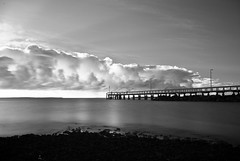Wellington Point Pier at sunrise while the sun was behind a large bank of clouds.
Single exposure taken at 18mm with the Pentax K200D and Pentax SMC DA 18-55 AL II lens. Shot at f8.0, 30 sec, ISO 200.
This shot is Infrared, shot using a Hoya R72 filter. All editing done in Lightroom 2.5 (clarity, blacks, white balance, greyscale, contrast)
I really like the extra contrast you get with the R72 filter. The required long exposure didnt hurt the smoothness of the water either
Showing posts with label hoya r72. Show all posts
Showing posts with label hoya r72. Show all posts
Tuesday, February 16, 2010
Wellington Point Pier - Hoya R72
This blog has moved to HERE!
Labels:
brisbane landmarks,
digital infrared,
hoya r72,
ir72,
pier,
sunrise
Wednesday, February 3, 2010
More Digital Infrared (IR) Photography
Here is another shot I took recently with my R72 type filter. In this case I used a Hoya R72 filter mounted to my Pentax K200D & Pentax SMC DA 18-55 AL II combo.
This shot was processed entirely in Lightroom 2.5 (no photoshop trickery going on here!). You can see here the effect quite well, the sky is nice and dark, while the trees are a bit brighter than they would otherwise be. If you compare closely to the image below you can see the difference quite well. The general contrast is also much stronger.
This shot was processed entirely in Lightroom 2.5 (no photoshop trickery going on here!). You can see here the effect quite well, the sky is nice and dark, while the trees are a bit brighter than they would otherwise be. If you compare closely to the image below you can see the difference quite well. The general contrast is also much stronger.
This is the same shot, but taken without an IR filter, just converted to greyscale in Lightroom.
And here is the IR shot in colour (with corrected White Balance and Exposure in Lightroom 2.5). This is what was coverted to greyscale to get the IR image above.
Tuesday, February 2, 2010
Infrared Digital Photography with an R72 Filter
This shot is from me playing around with an IR 720nm filter. This type of filter blocks all light below the 720nm wavelength. This means some reds, and infrared are the only light which can pass through. By using 1 of these filters on your camera, you will get some interesting results.
Unfortunately most modern cameras have an IR reduction filter mounted to the front of the sensor, which means that blocking visible light will result in very long exposures being required. This particular shot was taken in broad daylight, at f11.0, ISO 200 and required a 30 second shutter speed! 30 secs in broad daylight is quite a lot. A typical exposure in this situation would be around about 1/400 sec!
The main features of IR photography are black skies, and white leaves on trees and grass. This results in cool contrasty shots where things are just a little different to the norm.
Unfortunately most modern cameras have an IR reduction filter mounted to the front of the sensor, which means that blocking visible light will result in very long exposures being required. This particular shot was taken in broad daylight, at f11.0, ISO 200 and required a 30 second shutter speed! 30 secs in broad daylight is quite a lot. A typical exposure in this situation would be around about 1/400 sec!
The main features of IR photography are black skies, and white leaves on trees and grass. This results in cool contrasty shots where things are just a little different to the norm.
This blog has moved to HERE!
Subscribe to:
Posts (Atom)





